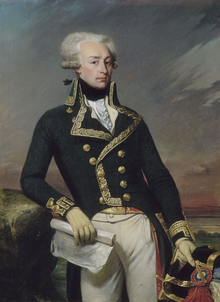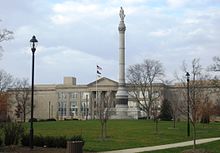Battle of Monmouth
In February 1778, the French-American Treaty of Alliance tilted the strategic balance in favor of the Americans, forcing the British to abandon hopes of a military victory and adopt a defensive strategy.The battle was tactically inconclusive and strategically irrelevant; neither side landed the blow they hoped to on the other, Washington's army remained an effective force in the field, and the British redeployed successfully to New York.Because of his tactless efforts to argue his case in the days after the battle, Washington had him arrested and court-martialed on charges of disobeying orders, conducting an "unnecessary, disorderly, and shameful retreat" and disrespect towards the commander-in-chief.In 1777, some two years into the American Revolutionary War, the British commander-in-chief General Sir William Howe launched the Philadelphia campaign to capture the rebels' capital and persuade them to sue for peace.[7] Washington was criticized in some quarters within the army and Congress for relying on a Fabian strategy to wear the British down in a long war of attrition instead of defeating it decisively in a pitched battle.[12] He successfully waged a "clever campaign of political infighting"[13] in which he presented a public image of disinterest, a man without guile or ambition, while working through his allies in Congress and the army to silence his critics.[15] The British, meanwhile, had failed to eliminate the Continental Army and force a decisive end to the American rebellion, despite investing significant resources in North America to the detriment of defenses elsewhere in the empire.They abandoned their efforts to win a decisive military victory, repealed the Intolerable Acts that had precipitated the rebellion and, in April 1778, sent the Carlisle Peace Commission in an attempt to reach a negotiated settlement.Recruitment failed to raise sufficient numbers, and the harsh discipline implemented by Washington, the long periods away from home and the defeats of 1777 further weakened the army through desertions and frequent officer resignations.[31][19] In April, before news of the French alliance reached him, Washington issued a memorandum to his generals seeking their opinions on three possible alternatives for the upcoming campaign: attack the British in Philadelphia, shift operations to New York or remain on the defensive at Valley Forge and continue to build up the army.Most generals supported one or other of the offensive options, but Washington sided with the minority, among them Steuben, who argued the Continental Army still needed improvement at Valley Forge before it was ready to take on the British.[39] The frequent sniping and skirmishing of Maxwell's Continentals and Dickinson's militia, and their attempts to obstruct and hinder the British by blocking roads, destroying bridges and spoiling wells, did not materially impede progress.He preferred not to risk the Continental Army against a professional, well-trained enemy until French intervention swayed the odds in the Americans' favor and proposed that Clinton should be allowed to proceed to New York unmolested.Even the most aggressive of the remainder wanted to avoid a major engagement; Brigadier General Anthony Wayne suggested the dispatch of 2,500–3,000 additional troops to reinforce Maxwell and Dickinson that would enable them, with a third of the army, to make "an Impression in force."In the absence of any intelligence about Clinton's intentions or the terrain, Lee believed it would be useless to form a precise plan of his own; he told his commanders only to be ready for action at short notice and follow his orders.When he observed part of Lafayette's force retreating after a failed attempt to silence some British artillery, it appeared to Lee that the right flank too was pulling back without orders.[102] Expecting praise for a retreat he believed had been generally conducted in good order, Lee was uncharacteristically lost for words when Washington asked without pleasantries, "I desire to know, sir, what is the reason – whence arises this disorder and confusion?He blamed faulty intelligence and his officers, especially Scott, for pulling back without orders, leaving him no choice but to retreat in the face of a superior force, and reminded Washington that he had opposed the attack in the first place.Even farther to the right, an attempt to outflank Stirling's position by the Queen's Rangers and the light infantry of the rearguard lacked the strength to carry it through, and they too fell back to join the 3rd Brigade.When a battalion of Grenadiers led by Lieutenant Colonel Henry Monckton chased Lee's troops over the bridge, the British found themselves facing Wayne's detachment reforming some 350 yards (320 m) away.[114] Washington had acted decisively to form a strong defensive position anchored on the right above the bridge on the Englishtown road and extending in a gentle curve one-half mile (one kilometer) up the slope of Perrine's Hill.His second division covered by the Hessian Jägers under Lieutenant Colonel Wurmb[133] endured only light harassment from militia along the way, and eventually set up camp some three miles (five kilometers) from Middletown.The timing was fortuitous for the British; on July 11, a superior French fleet commanded by Vice Admiral Charles Henri Hector d'Estaing anchored off Sandy Hook.While some of his officers showed a grudging respect for the Continental Army, their doubts were rooted not in the battlefield but in the realisation that the entry of France into the conflict had swung the strategic balance against Great Britain.[158][159][160] The court convened on July 4, and three charges were laid before Lee: disobeying orders in not attacking on the morning of the battle, contrary to "repeated instructions"; conducting an "unnecessary, disorderly, and shameful retreat"; and disrespect towards the commander-in-chief.He denigrated the commander-in-chief's role in the battle, calling Washington's official account "from beginning to end a most abominable damn'd lie", and disingenuously cast his own decision to retreat as a "masterful manoeuvre" designed to lure the British onto the main body.[169][r] Joseph Bilby and Katherine Jenkins consider the battle to have marked the "coming of age" of a Continental Army that had previously achieved success only in small actions at Trenton and Princeton.The role Lee had unsuccessfully advanced for the militia in the revolution was finally established in the poetic 19th-century popular narrative, in which the Continental Army was excised from the battle and replaced with patriotic citizen-soldiers.[181] The battlefield remained largely undisturbed until 1853, when the Freehold and Jamesburg Agricultural Railroad opened a line that cut through the Point of Woods, across the Spotswood Middle Brook and through the Perrine estate.The state park helped restore a more realistic interpretation of the history of the battle to the public memory, and the Continental Army takes its rightful place in the annual reenactments staged every June.











Battle of Monmouth (1233)Philadelphia campaignAmerican Revolutionary WarEmanuel LeutzeManalapan TownshipFreehold TownshipMonmouthNew JerseyUnited StatesGreat BritainGeorge WashingtonCharles LeeSir Henry ClintonBound BrookShort HillsStaten IslandCooch's BridgeBrandywineCloudsGermantownRed BankFort MifflinGloucesterWhite MarshMatson's FordValley ForgeConway CabalQuinton's BridgeClow RebellionCrooked BilletBarren HillCarlisle Peace CommissionFreehold Borough, New JerseyContinental ArmyBritish ArmyHenry ClintonPhiladelphiaHoratio GatesTreaty of AllianceMajor GeneralvanguardCongressNew Jersey State ParkMonmouth Battlefield State ParkFranco-American AllianceWashington at PrincetonCharles Willson PealeWilliam HoweSecond Continental CongressYork, PennsylvaniaBattles of SaratogaFabian strategyThomas ConwayInspector General of the ArmyBoard of War and OrdnanceconspiracyempireAnglo-French War (1778–1783)hostile neutralityFourth Anglo-Dutch WarIntolerable ActsAndrea SoldiBattle of Long IslandFriedrich Wilhelm von SteubenNew York2nd New Jersey RegimentWilliam MaxwellNew Jersey militiaPhilemon DickinsonLafayetteBattle of Barren HillHaddonfieldAllentownLieutenant GeneralCharles Lord CornwallisWilhelm von KnyphausenpioneersbattalionImlaystownSandy HookRoyal NavyFreeholdGuardsGrenadiersMonmouth CountyPatriotsLoyalistsQueen's American RangersCoryell's FerryLord StirlingHopewellColonelDaniel MorganJoseph Stout HouseAnthony WayneLieutenant ColonelAlexander HamiltonCharles ScottNathanael GreeneLouis DuportailBattle of TrentonJoseph-Désiré CourtEnglishtownJames VarnumManalapan BridgeMonmouth order of battleWilliam GraysonMiddletowndragoonsRichard ButlerHenry JacksonShrewsburyRoyal ArtillerymusketsJohn ClarkWilliam Woodford42nd (Royal Highland) Regiment of Foot44th Regiment of FootHenry MoncktonJoseph Cilley33rd Regiment of FootEnoch PoorJägersCharles Henri Hector d'EstaingMonmouth County Historical AssociationGeorge Germain
